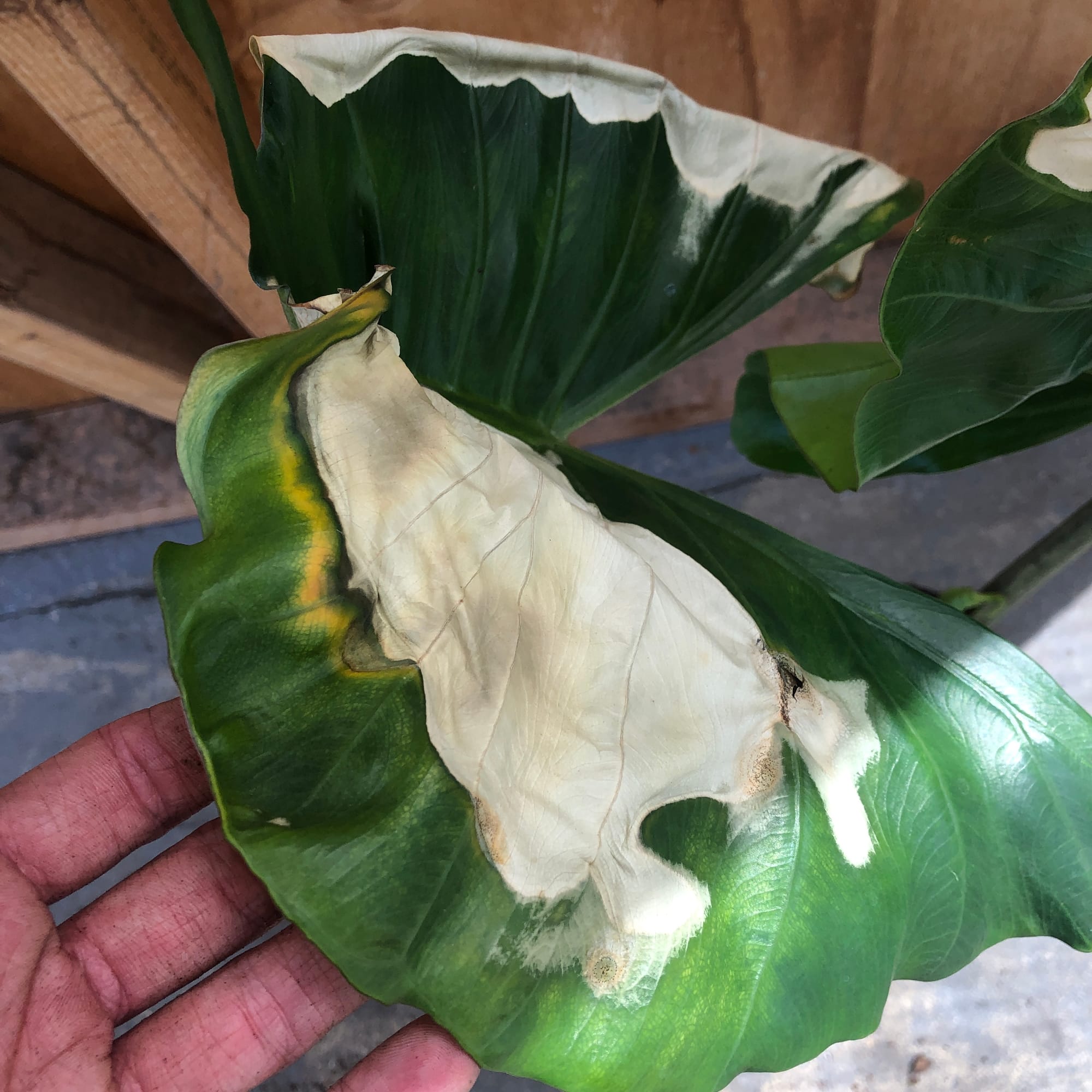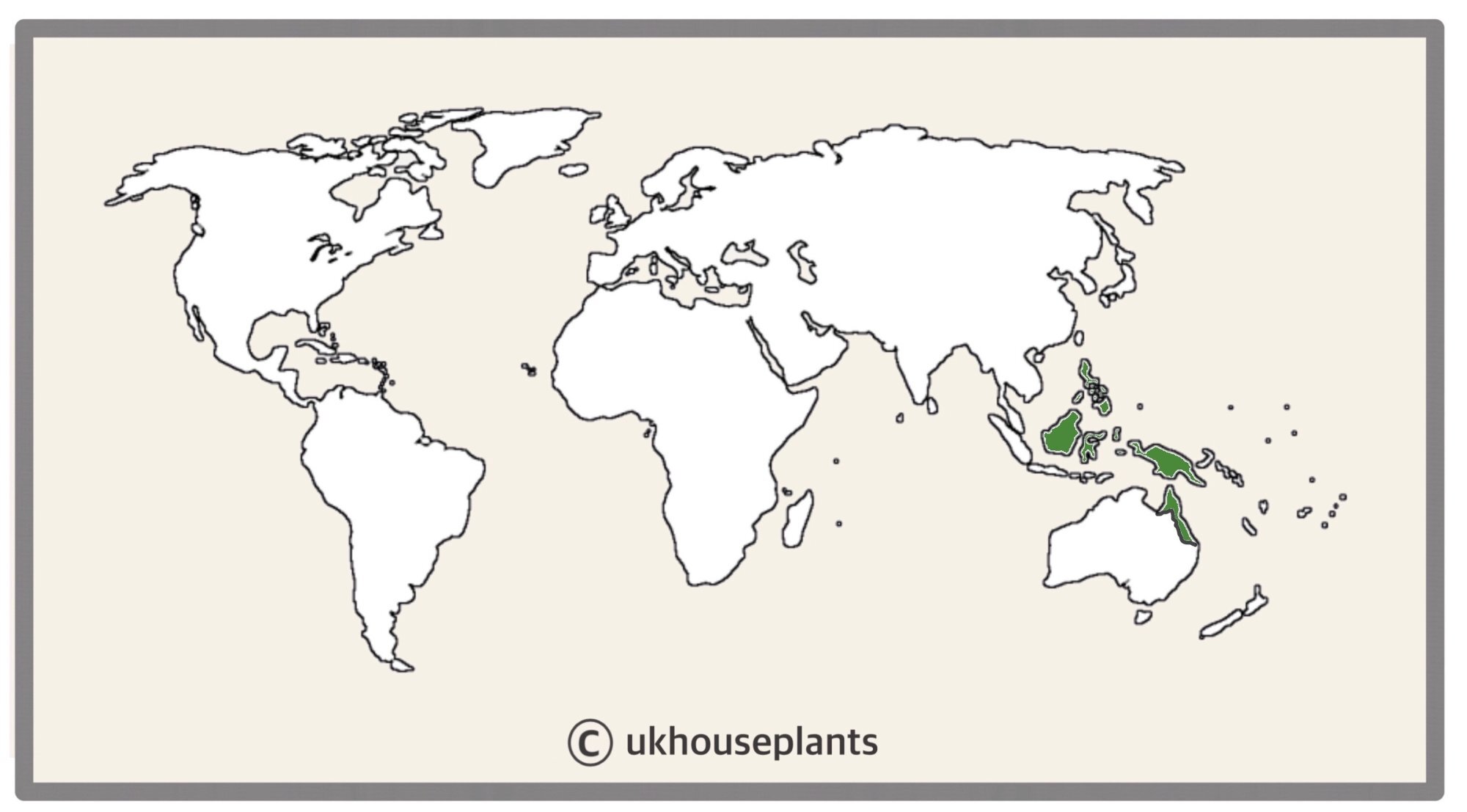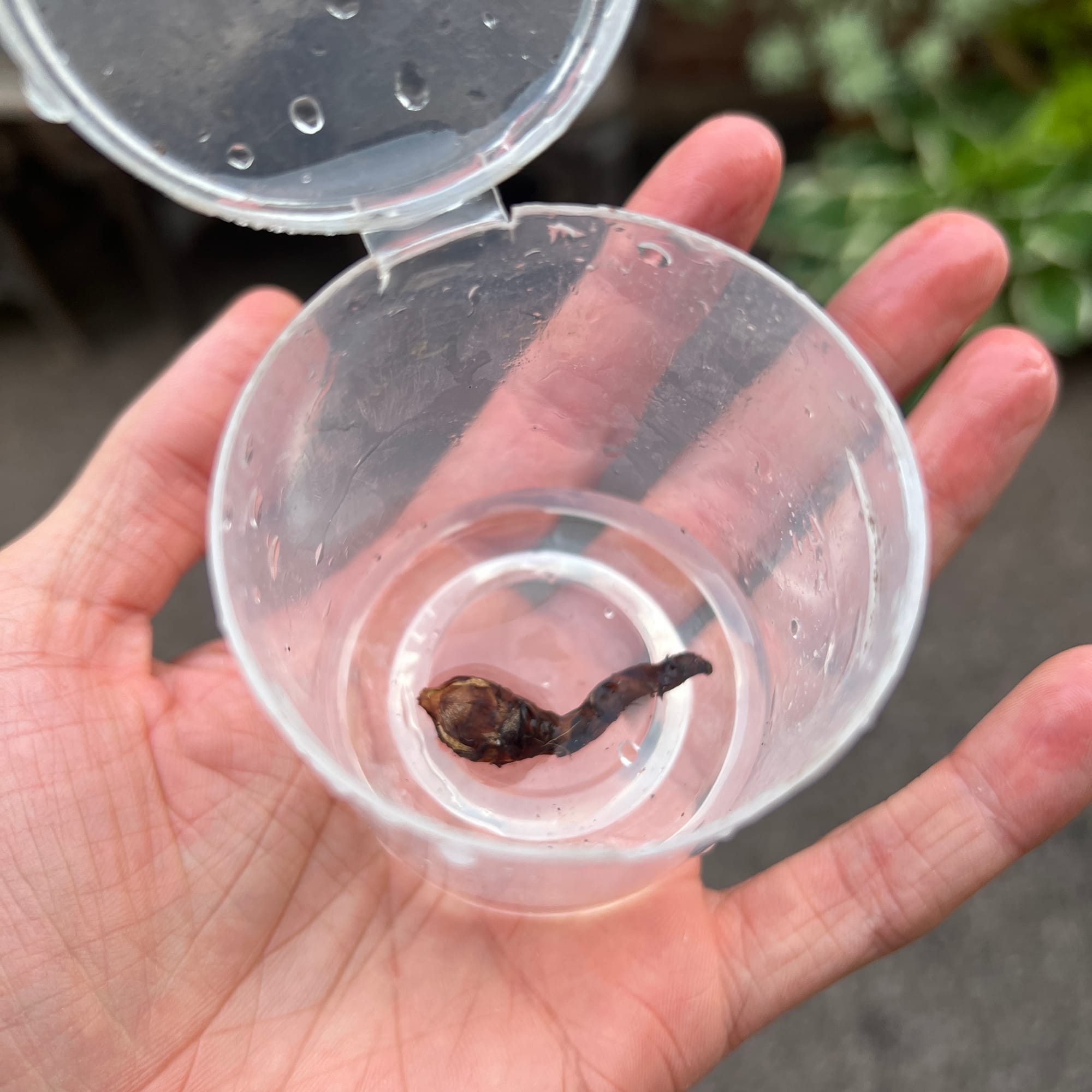
Alocasia macrorrhiza 'Stingray'
Contents
- Top Tips
- Location, Water, Humidity & Fertilisation
- Common Issues
- Origins, Temperature, Propagation, Repotting & Toxicity.
Need the answer to a specific plant query? Book a 1-to-1 video call with THE HOUSEPLANT DOCTOR™, the website's friendly author, to overcome and address your niggling problem! Available on iMessage, WhatsApp, Facebook Messenger & more.
Top Tips & Info
- Care Difficulty - Easy to Moderate
- Keep the soil evenly moist, allowing the top third to dry out in between waters. Avoid water-logging or extended periods of soggy-soil.
- Mist the foliage or introduce a humidity tray whilst the heaters are operating.
- Bright indirect light is best, avoiding exposure to the summer sun. An hour or two of winter sunlight is highly beneficial, though.
- Fertilise using a 'Houseplant' labelled feed every four waters in the spring and summer, reducing this to every six in the colder months.
- Keep an eye out for Spider Mites that'll form webs on the under-leaves of the plant.
- Especially if its kept in a dark location, wash or dust the foliage monthly, to increase the light-capturing efficiency.
- Repot every two years, using a 'Houseplant' labelled compost and the next sized pot with drainage holes.
Location & Light - 🔸🔸
Although bright, indirect sun is ideal, throw in some morning or evening sun if possible. If it's situated in a shady location, dust the leaves from time to time to improve light-capturing efficiency. Never allow an Alocasia to sit in strong sunlight for extended periods, as too much light will result in a pale, washed-out appearance with possible brown patches forming on the leaves.
Water - 🔸🔸
Allow around a third of the soil dry out in between irrigations during spring and summer, with monthly waters in the cooler months. Alocasia are usually situated in a well-draining medium, meaning that standing water could be an issue beneath the pot. Use tepid water if possible; many houseplants' root systems are super sensitive to temperature change, so don't get caught out by this as it could result in yellowing leaves. Under-watering symptoms include wilting, little to no growth and greying leaves - these issues are commonly down to too much light/heat, or forgetfulness. Alternatively, over-watering symptoms include rapidly yellowing lower leaves, wilting (root rot), brown spots on leaves, and a rotten stem. Do not situate an Alocasia in dark locations with much water, as root rot and leaf spot disease will quickly arise. For more information on how to address this issue, scroll down to 'Common Issues'.
Humidity - 🔸🔸🔸
Create a humidity tray to provide a moist and stable environment for your plant. If the surrounding saturation is too low or the heat too high, its leaf-tips may start to brown over and curl, especially in direct sunlight. Gently hose the foliage down from time to time to hydrate the leaves and keep the dust levels down.
Fertilisation - 🔸🔸
Fertilise every four waters during the growing period before reducing this to every six in the autumn & winter. Although an 'All-Purpose' fertiliser will still do the job, we'd recommend using a specific 'Houseplant' labelled fertiliser as it'll support the vital thirteen nutrients that this species will need to grow.
Common Issues with Alocasia
Regular irrigations are key. Periods of droughts will quickly slip the Alocasia back into its dormancy period, causing stunted growth and a bewildered plant owner. If it hasn't repotted in a while, there may be too many roots and not enough soil to retain moisture, thus leaving the soil to dry out quicker. Click on this link to learn more about a transplant.
Pest damage can also cause issues down the line. Spider Mites and Mealybugs tend to be the usual inhabitants; check the leaves' undersides and along the leaf's central archway (midrib) for possible colonies. Spider Mites are minute, almost transparent critters that roam around the leaf faces in search of chlorophyll, whereas mealybugs are white and are quite noticeable after a while. Both have an 'HQ' for their colonies that must be destroyed in order to reduce the overall population. Click on this link for more information.
 Due to its thin leaf tissue, Stingray Alocasia can't tolerate being in direct sunlight for more than thirty minutes a day, especially during the hot summer months. If this has occurred with yours, click on the image to learn more about Sun Scorch!
Due to its thin leaf tissue, Stingray Alocasia can't tolerate being in direct sunlight for more than thirty minutes a day, especially during the hot summer months. If this has occurred with yours, click on the image to learn more about Sun Scorch!
Dust the leaves regularly. Although this isn't too much of an issue, a build-up of dust particles can clog up the plant's pores, causing lowered light capturing-efficiency. Wipe the topside of the leaves down once a month to keep levels down and improve growing conditions.
If your Stingray Alocasia begins to wilt, it could be the product of one or many issues, ranging from the environment to your care habits. If the specimen is located in too low light, it may lead to plant-confusion when the window is several metres away. As mentioned in 'Location & Light', most Alocasia will require overhead lighting to complement its growth habit, with anything else causing either wilting or slanted growth. Secondly, irregular watering habits could cause root dehydration, which will eventually lead to wilting. Prolonged droughts will result in a lack of hydration in the upper part of the plant, with root rot doing the same - albeit it with overly soggy compost. Finally, environment shock could be the final culprit of your wilting Alocasia. If the specimen has recently been purchased or relocated, the chances are that the specimen hasn't acclimated itself to the new environment. Be sure to provide a bright, indirect setting with the best possible angle to the light source (overhead or nearby a window). Maintain relatively moist soil, allowing the top third to dry between waters and fertilise every two to four weeks, depending on the current season. If you still have questions about your poorly Alocasia, be sure to book a 1-to-1 Call with THE HOUSEPLANT DOCTOR™ to discuss this further!
 Alocasia can be riddled with pests due to its thin, broad leaves. In the image above, there's a third point of interest to look at - mineral/calcium deposits. This is a natural part of an Alocasia leaf's lifecycle, so don't worry about removing them!
Alocasia can be riddled with pests due to its thin, broad leaves. In the image above, there's a third point of interest to look at - mineral/calcium deposits. This is a natural part of an Alocasia leaf's lifecycle, so don't worry about removing them!
Yellowing leaves - it's difficult to accurately pinpoint why this is happening as it could be due to many different reasons. If the lower leaves are yellowing in quick concession, it could be over-watering. Do not allow the soil to become soil or waterlogged; failure to do so will cause root rot and possible death. For severe cases, take the plant out of rot pot to examine for root rot - a transplant may have to be performed. The second reason why its leaves are yellowing could be due to either too much sunlight or not enough water. As mentioned above, under-watering can cause an Alocasia to slip into its dormancy period, but persistent droughts with direct sunlight will cause further damage in the likes of yellowing leaves, stunted growth and wilting.
Snapped stems are common with Stingray Alocasia that are grown too low light. Increase the light levels by placing it as close to a sunless windowsill as possible. If it's too big for a windowsill, try placing it directly in front to help the plant grow stronger, more upright stems. You can either try strengthening the damaged stem by using a chopstick as support or simply prune it entirely off.
Too low humidity can cause browning leaf tips with yellow halos. Although this won't kill the plant, increase humidity to prevent new growth in adopting these symptoms. Either mist weekly while the heaters are on, or create your humidity tray.
Origins
Alocasia is a genus of around seventy species, originating from tropical locations forests in Southeastern Asia and northern Australia. Unfortunately, not much is known about the Stingray Alocasia; some botanists believe that it is an interspecific hybrid, with others leaning towards the idea of it being a naturally-occurring cultivar.
 The Projected Distribution of Alocasia macrorrhiza 'Stingray'.
The Projected Distribution of Alocasia macrorrhiza 'Stingray'.
Temperature
10° - 30°C (50° - 86°F)
H1b (Hardiness Zone 12) - Can be grown outdoors during the summer in a sheltered location with temperatures above 12℃ (54℉), but is fine to remain indoors, too. If you decide to bring this plant outdoors, don't allow it to endure any direct sunlight as it may result in sun-scorch and dehydration. Regularly keep an eye out for pests, especially when re-introducing it back indoors.
Spread
Over 0.7m in height and 0.5m in width once they reach maturity. The ultimate height will take between 5 - 10 years to achieve.
Pruning & Maintenance
Remove yellow or dying leaves, and plant debris to encourage better-growing conditions. While pruning, always use clean utensils or shears to reduce the chance of bacterial and fungal diseases. Never cut through yellowed tissue as this may cause further damage in the likes of diseases or bacterial infections. Remember to make clean incisions as too-damaged wounds may shock the plant, causing weakened growth and a decline in health.
Propagation
Via Seed or Corm Propagation
Seeds (Difficult) - This form of propagation isn't common due to the difficulties growers might face trying to source seeds. For those who have the seeds ready, submerge the Alocasia seeds around 1cm deep in an 'Alocasia' labelled potting mix in a seed tray. Maintain reliable soil moisture and provide a bright, sunless windowsill while they germinate. You can separate the seedlings into individual 5cm pots once they produce their third leaf.
Corms (Easy to Moderate) - Most Alocasia are have corms, which are small globular-shaped brown bulbs that'll grow along the root system. A mature Stingray Alocasia can produce over ten corms at any time and can be harvested when you next repot it. Here's how to do it;
- The best time to repot is during the spring or early summer. Make sure that a few hours before repotting, you water the plant's soil to reduce the risk of 'transplant shock' when the roots are disturbed in dry soil.
- Take the mother plant out of its pot and gently work your fingers through the rootball (& soil) until you feel the small brown ball-shaped 1-2cm corms. Have a look at the image below for what they look like!
- With a clean pair of scissors or a knife, cut off the corm via the 'rhizome' (root) that attaches it to the mother's root system. Make sure around 0.5cm+ of the 'rhizome' is still attached to the corm, so don't prune too close to the bulb itself. Have a look at the images below.
- Once separated, place the corm sideways in a small glass (like a shot glass) or plastic cup. Pour around 20ml of water, so it creates a small puddle of water which should submerge around 10% of the corm. Do not fully submerge the corm as this could result in it rotting. Place the corm (in its container) in a warm, bright windowsill until roots develop which will take between 2-8 weeks. Replace the water twice a week to remove any bacteria. See the image below!
- One the roots are around 3cm (1in) in length (pictured below), plant it in fresh 'Alocasia' labelled potting mix in a 5-7cm plastic pot.
- With the mother plant, repot her back into its orignal pot with a fresh batch of 'Alocasia' labelled potting mix. If you're growing the mother Alocasia in hydroponics, repot this back into the same pot with fresh potting medium.

This is how you 'puddle' an Alocasia corm by submerging it in water to root. Never submerge the entire corm in water as this increases the likelihood of it rotting.
 Extra Tip: A healthy corm should be solid when pinched. Discard any bulbs that are softened or rotten as the bacteria will kill the whole corm.
Extra Tip: A healthy corm should be solid when pinched. Discard any bulbs that are softened or rotten as the bacteria will kill the whole corm.
 Here's a corm that THE HOUSEPLANT DOCTOR™ has grown hydroponically and is now ready to be planted in either soil or moss. (He recommends Sphagnum Moss as a good growing medium).
Here's a corm that THE HOUSEPLANT DOCTOR™ has grown hydroponically and is now ready to be planted in either soil or moss. (He recommends Sphagnum Moss as a good growing medium).
Flowers
As Alocasia is part of the Araceae family, their flowers aren't showy. Much like a Peace Lily's flower body, their flowers consist of a white or green spathe (the spoon-like shell) with the spadix being the site of pollination. Blooms can last up to five days and is usually visible during late spring or early summer around 30cm+ from the soil line.
Repotting
Repot every two years in the spring, using a 'Houseplant' labelled potting mix and the next sized pot with adequate drainage. Alocasia are far better potbound for several years due to the heightened risk of root rot and repotting-issues (like transplant shock), so only repot if you feel it's wholly necessary - restricted root growth will also increase the chance of blooms, too.
Hydrate the plant 24hrs before tinkering with the roots to prevent the risk of transplant shock. For those situated in a darker location, introduce an extra amount of perlite and grit into the deeper portion of the pot to downplay over-watering risks. Click on this link for a detailed step-by-step guide on transplantation, or via this link to learn about repotting with root rot.
Book a 1-to-1 video call with THE HOUSEPLANT DOCTOR™ if you'd like a personal guide to repotting your houseplant. This will include recommending the right branded-compost and pot size, followed by a live video call whilst you transplant the specimen for step-by-step guidance and answer any further questions!
Pests & Diseases
Keep an eye out for mealybugs, spider mites, scale, thrips, fungus gnats, vine weevils & root mealybugs that'll locate themselves in the cubbyholes and undersides of the leaves, with the exception of the latter two in the soil. Common diseases associated with Alocasia are root rot, leaf-spot disease, botrytis, rust, powdery mildew & southern blight - click here to learn more about these issues.
Toxicity
Members of the Araceae family typically contain poisonous calcium oxalate crystals, with Alocasia being no exception. Other members of this family include Philodendron, Zamioculcas (ZZ Plants) and Spathiphyllum (Peace Lilies). If eaten, vomiting, nausea with a loss of appetite could occur and consumption of large quantities must be dealt with quickly.
Retail Locations
Online Stores.
Book a 1-to-1 Call with Joe Bagley
If you need further advice with your houseplants, book an advice call with ukhouseplants' friendly and expert writer today! This can be done via a video or audio call on most apps, including Facebook, FaceTime & Skype. A ten-minute call costs £5.99 (US$7), or £15.99 for thirty minutes. You can ask multiple questions, including queries on plants, pests, terrariums, repotting advice and anything in between. Please consider supporting this service to keep ukhouseplants thriving!